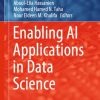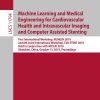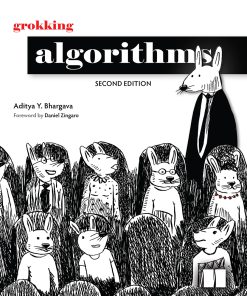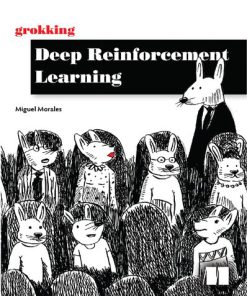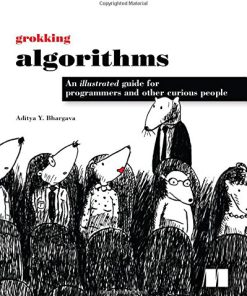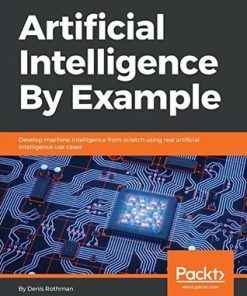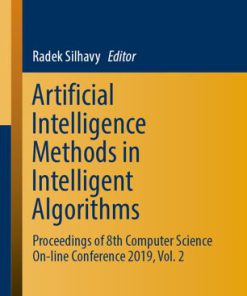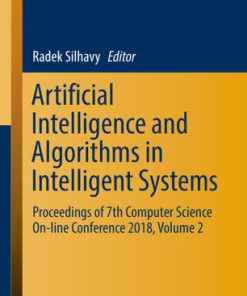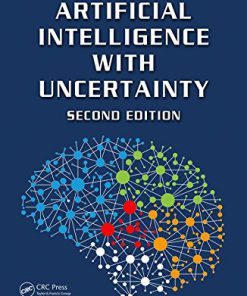Grokking Artificial Intelligence Algorithms 1st Edition by Rishal Hurbans 1638355687 9781638355687
$50.00 Original price was: $50.00.$25.00Current price is: $25.00.
Grokking Artificial Intelligence Algorithms 1st Edition by Rishal Hurbans – Ebook PDF Instant Download/DeliveryISBN: 1638355687, 9781638355687
Full download Grokking Artificial Intelligence Algorithms 1st Edition after payment.
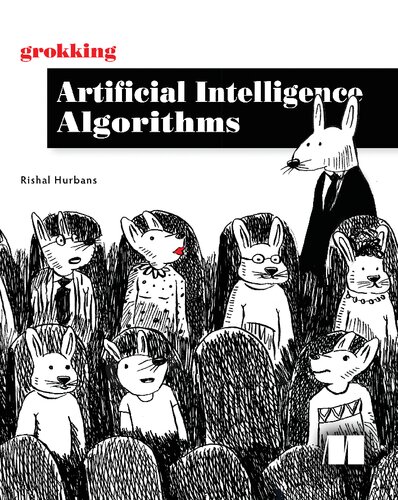
Product details:
ISBN-10 : 1638355687
ISBN-13 : 9781638355687
Author: Rishal Hurbans
“From start to finish, the best book to help you learn AI algorithms and recall why and how you use them.” – Linda Ristevski, York Region District School Board ”This book takes an impossibly broad area of computer science and communicates what working developers need to understand in a clear and thorough way.” – David Jacobs, Product Advance Local Key Features Master the core algorithms of deep learning and AI Build an intuitive understanding of AI problems and solutions Written in simple language, with lots of illustrations and hands-on examples Creative coding exercises, including building a maze puzzle game and exploring drone optimization About The Book “Artificial intelligence” requires teaching a computer how to approach different types of problems in a systematic way. The core of AI is the algorithms that the system uses to do things like identifying objects in an image, interpreting the meaning of text, or looking for patterns in data to spot fraud and other anomalies. Mastering the core algorithms for search, image recognition, and other common tasks is essential to building good AI applications Grokking Artificial Intelligence Algorithms uses illustrations, exercises, and jargon-free explanations to teach fundamental AI concepts.You’ll explore coding challenges like detecting bank fraud, creating artistic masterpieces, and setting a self-driving car in motion. All you need is the algebra you remember from high school math class and beginning programming skills. What You Will Learn Use cases for different AI algorithms Intelligent search for decision making Biologically inspired algorithms Machine learning and neural networks Reinforcement learning to build a better robot This Book Is Written For For software developers with high school–level math skills. About the Author Rishal Hurbans is a technologist, startup and AI group founder, and international speaker. Table of Contents 1 Intuition of artificial intelligence 2 Search fundamentals 3 Intelligent search 4 Evolutionary algorithms 5 Advanced evolutionary approaches 6 Swarm intelligence: Ants 7 Swarm intelligence: Particles 8 Machine learning 9 Artificial neural networks 10 Reinforcement learning with Q-learning
Grokking Artificial Intelligence Algorithms 1st Table of contents:
1 Intuition of artificial intelligence
What is artificial intelligence?
Defining AI
Understanding that data is core to AI algorithms
Viewing algorithms as instructions in recipes
A brief history of artificial intelligence
Problem types and problem-solving paradigms
Search problems: Find a path to a solution
Optimization problems: Find a good solution
Prediction and classification problems: Learn from patterns in data
Clustering problems: Identify patterns in data
Deterministic models: Same result each time it’s calculated
Stochastic/probabilistic models: Potentially different result each time it’s calculated
Intuition of artificial intelligence concepts
Narrow intelligence: Specific-purpose solutions
General intelligence: Humanlike solutions
Super intelligence: The great unknown
Old AI and new AI
Search algorithms
Biology-inspired algorithms
Machine learning algorithms
Deep learning algorithms
Uses for artificial intelligence algorithms
Agriculture: Optimal plant growth
Banking: Fraud detection
Cybersecurity: Attack detection and handling
Health care: Diagnosis of patients
Logistics: Routing and optimization
Telecoms: Optimizing networks
Games: Creating AI agents
Art: Creating masterpieces
Summary of Intuition of artificial intelligence
2 Search fundamentals
What are planning and searching?
Cost of computation: The reason for smart algorithms
Problems applicable to searching algorithms
Representing state: Creating a framework to represent problem spaces and solutions
Graphs: Representing search problems and solutions
Representing a graph as a concrete data structure
Exercise: Represent a Graph as a Matrix
Solution: Represent a Graph as a Matrix
Trees: The concrete structures used to represent search solutions
Uninformed search: Looking blindly for solutions
Breadth-first search: Looking wide before looking deep
Exercise: Determine the path to the solution
Solution: Determine the path to the solution
Depth-first search: Looking deep before looking wide
Exercise: Determine the path to the solution
Solution: Determine the path to the solution
Use cases for uninformed search algorithms
Optional: More about graph categories
Optional: More ways to represent graphs
Incidence matrix
Adjacency list
Summary of search fundamentals
3 Intelligent search
Defining heuristics: Designing educated guesses
Thought Experiment: Given the following scenario, what heuristic can you imagine?
Thought Experiment: Possible solution
Informed search: Looking for solutions with guidance
A* search
Use cases for informed search algorithms
Adversarial search: Looking for solutions in a changing environment
A simple adversarial problem
Min-max search: Simulate actions and choose the best future
Heuristics
Exercise: What values would propagate in the following Min-max tree?
Solution: What values would propagate in the following Min-max tree?
Alpha-beta pruning: Optimize by exploring the sensible paths only
Use cases for adversarial search algorithms
Summary of Intelligent search
4 Evolutionary algorithms
What is evolution?
Problems applicable to evolutionary algorithms
Genetic algorithm: Life cycle
Encoding the solution spaces
Binary encoding: Representing possible solutions with zeros and ones
Exercise: What is a possible encoding for the following problem?
Solution: What is a possible encoding for the following problem?
Creating a population of solutions
Measuring fitness of individuals in a population
Selecting parents based on their fitness
Steady state: Replacing a portion of the population each generation
Generational: Replacing the entire population each generation
Roulette wheel: Selecting parents and surviving individuals
Reproducing individuals from parents
Single-point crossover: Inheriting one part from each parent
Two-point crossover: Inheriting more parts from each parent
Uniform crossover: Inheriting many parts from each parent
Exercise: What outcome would uniform crossover generate for these chromosomes?
Solution: What outcome would uniform crossover generate for these chromosomes?
Bit-string mutation for binary encoding
Flip-bit mutation for binary encoding
Populating the next generation
Exploration vs. exploitation
Stopping conditions
Configuring the parameters of a genetic algorithm
Use cases for evolutionary algorithms
Summary of evolutionary algorithms
5 Advanced evolutionary approaches
Evolutionary algorithm life cycle
Alternative selection strategies
Rank selection: Even the playing field
Tournament selection: Let them fight
Elitism selection: Choose only the best
Real-value encoding: Working with real numbers
Real-value encoding at its core
Arithmetic crossover: Reproduce with math
Boundary mutation
Arithmetic mutation
Order encoding: Working with sequences
Importance of the fitness function
Order encoding at its core
Order mutation: Order/permutation encoding
Tree encoding: Working with hierarchies
Tree encoding at its core
Tree crossover: Inheriting portions of a tree
Change node mutation: Changing the value of a node
Common types of evolutionary algorithms
Genetic programming
Evolutionary programming
Glossary of evolutionary algorithm terms
More use cases for evolutionary algorithms
Summary of advanced evolutionary approaches
6 Swarm intelligence: Ants
What is swarm intelligence?
Problems applicable to ant colony optimization
Exercise: Find the shortest path in this carnival configuration by hand
Solution: Find the shortest path in this carnival configuration by hand
Representing state: What do paths and ants look like?
The ant colony optimization algorithm life cycle
Initialize the pheromone trails
Set up the population of ants
Choose the next visit for each ant
The stochastic nature of ants
Selecting destination based on a heuristic
Exercise: Determine the probabilities of visiting the attractions with the following information
Solution: Determine the probabilities of visiting the attractions with the following information
Update the pheromone trails
Updating pheromones due to evaporation
Updating pheromones based on ant tours
Exercise: Calculate the pheromone update given the following scenario
Solution: Calculate the pheromone update given the following scenario
Update the best solution
Determine the stopping criteria
Use cases for ant colony optimization algorithms
Summary of ant colony optimization
7 Swarm intelligence: Particles
What is particle swarm optimization?
Optimization problems: A slightly more technical perspective
Exercise: How many dimensions will the search space for the following scenario be?
Solution: How many dimensions will the search space for the following scenario be?
Problems applicable to particle swarm optimization
Representing state: What do particles look like?
Particle swarm optimization life cycle
Initialize the population of particles
Calculate the fitness of each particle
Exercise: What would the fitness be for the following inputs given the drone fitness function?
Solution: What would the fitness be for the following inputs given the drone fitness function?
Update the position of each particle
The components of updating velocity
Updating velocity
Position update
Exercise: Calculate the new velocity and position for particle 1 given the following information about the particles
Solution: Calculate the new velocity and position for particle 1 given the following information about the particles
Determine the stopping criteria
Use cases for particle swarm optimization algorithms
Summary of particle swarm optimization
8 Machine learning
What is machine learning?
Problems applicable to machine learning
Supervised learning
Unsupervised learning
Reinforcement learning
A machine learning workflow
Collecting and understanding data: Know your context
Preparing data: Clean and wrangle
Missing data
Ambiguous values
Encoding categorical data
Exercise: Identify and fix the problem data in this example
Solution: Identify and fix the problem data in this example
Testing and training data
Training a model: Predict with linear regression
Fitting a line to the data
Finding the mean of the features
Finding regression lines with the least-squares method
Exercise: Calculate a regression line using the least-squares method
Solution: Calculate a regression line using the least-squares method
Testing the model: Determine the accuracy of the model
Separating training and testing data
Measuring the performance of the line
Improving accuracy
Classification with decision trees
Classification problems: Either this or that
Exercise: Regression vs. Classification
Solution: Regression vs. Classification
The basics of decision trees
Training decision trees
Data structures for decision trees
Decision-tree learning life cycle
Exercise: Calculating uncertainty and information gain for a question
Solution: Calculating uncertainty and information gain for a question
Classifying examples with decision trees
Other popular machine learning algorithms
Use cases for machine learning algorithms
Summary of machine learning
9 Artificial neural networks
What are artificial neural networks?
The Perceptron: A representation of a neuron
Exercise: Calculate the output of the following input for the Perceptron
Solution: Calculate the output of the following input for the Perceptron
Defining artificial neural networks
Forward propagation: Using a trained ANN
Exercise: Calculate the prediction for the example BY using forward propagation with the following ANN
Solution: Calculate the prediction for the example BY using forward propagation with the following ANN
Backpropagation: Training an ANN
Phase A: Setup
Phase B: Forward propagation
Phase C: Training
Exercise: Calculate the new weights for the highlighted weights
Solution: Calculate the new weights for the highlighted weights
Options for activation functions
Designing artificial neural networks
Inputs and outputs
Hidden layers and nodes
Weights
Bias
Activation functions
Cost function and learning rate
Artificial neural network types and use cases
Convolutional neural network
Recurrent neural network
Generative adversarial network
Summary of artificial neural networks
10 Reinforcement learning with Q-learning
What is reinforcement learning?
The inspiration for reinforcement learning
Problems applicable to reinforcement learning
The life cycle of reinforcement learning
Simulation and data: Make the environment come alive
Training with the simulation using Q-learning
Exercise: Calculate the change in values for the Q-table
Solution: Calculate the change in values for the Q-table
Testing with the simulation and Q-table
Measuring the performance of training
Model-free and model-based learning
Deep learning approaches to reinforcement learning
Use cases for reinforcement learning
Robotics
Recommendation engines
Financial trading
Game playing
Summary of reinforcement learning
People also search for Grokking Artificial Intelligence Algorithms 1st:
borrow grokking artificial intelligence algorithms
grokking artificial intelligence algorithms pdf github
grokking artificial intelligence algorithms github
grokking artificial intelligence algorithms reddit
grokking artificial intelligence
Tags: Grokking, Artificial Intelligence, Algorithms, Rishal Hurbans
You may also like…
Children's Books - Education & Reference
Grokking Algorithms 2nd Edition by Aditya Bhargava ISBN 1638354561 9781638354567
Computers - Artificial Intelligence (AI)
Grokking Deep Reinforcement Learning First Edition Miguel Morales
Computers - Algorithms and Data Structures
Computers - Computer Science
Computers - Computer Science
Computers - Computer Science
Artificial Intelligence with Uncertainty 2nd Edition byDu Deyi Li 1498776272 9780367573683


